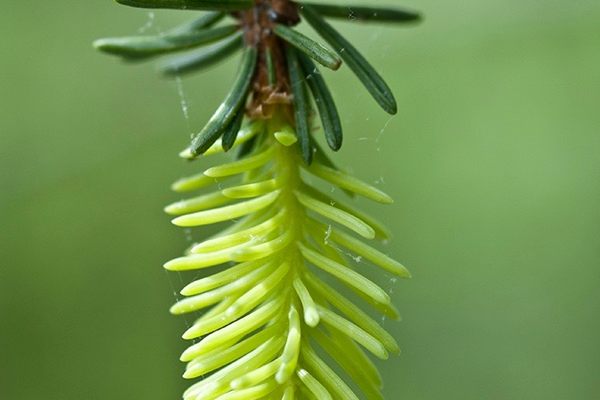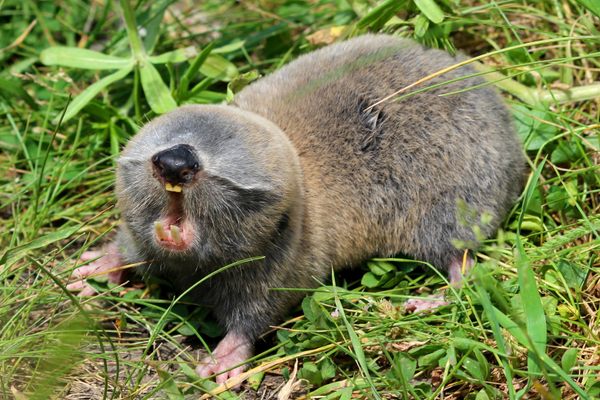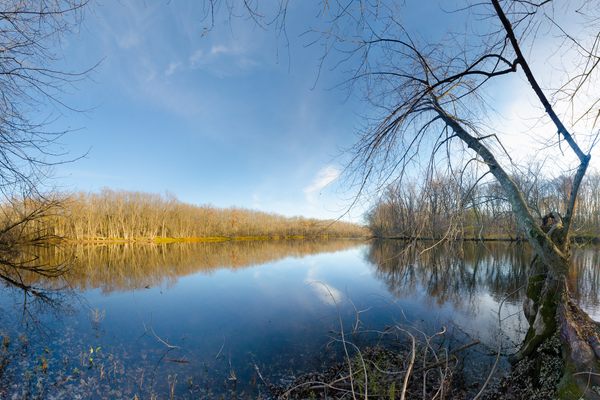Forests Can Handle Hurricanes, Unless Humans Interfere
A forest’s recovery can be long and slow, but surprisingly successful.

The Harvard Forest Hurricane Manipulation project in 1990. (Photo: Marcheterre Fluet)

When Jerome Howard visited the forest in the Bayou Sauvage refuge after Hurricane Katrina, in May 2006, he found a tangle of blown-down trunks. Most of the standing trees were dead, too. The forest was grey and barren. The trees that had survived looked to be Chinese tallow trees, an invasive species.

Years earlier, Howard, an associate professor at the University of New Orleans, had chosen this spot to study the effect of Chinese tallow on the insects cycling nutrients back into the soil. That study “was more or less hijacked by the storm,” he says. There were no insects, no snakes, no small animals to be seen, and he couldn’t locate the sites he had spent years working on.
Before the storm, you could see a quarter mile through an open gallery of green shade from the ridge. It had felt like a secret. The forest was on a ridge that had been cleared in the 1840s for sugar cane, then left to grow wild with oaks, maples and palmettos. Faced with the site’s devastation, Howard changed his plan. He would study the damage the hurricane had done to this piece of forest.
When a hurricane makes landfall, trees lose leaves and branches; they sway, twist, and rock, until some bend or break. Detached branches or falling trunks damage other trees. The water, soaking the soil and loosening its hold on roots, makes it easier for the wind to wreak havoc. Salt water, flooding in, can kill on its own: the trees that Howard saw still standing had been killed by the storm surge.

The refuge after Katrina. (Photo: US FWS)
Across the Gulf, forests lost an estimated 320 million large trees to Hurricane Katrina. Baldcypress, with its knobbly roots kneeling above the ground, could withstand the storm, but in areas of red maple and sweetgum, sometimes two-thirds of the trees were damaged. New Orleans lost 70 percent of its urban forest, not just during the storm but in the cleanup that followed, too. It can take 20 years for a forest to recover from a hurricane. The Gulf’s forest are only about halfway through their convalescence.
In the days and years after a storm, humans focus on the damage to our homes and cities before they worry about more wild places–but there’s a good reason for us to investigate what’s happened in our forests, too. Forests are one of our best allies against climate change, yet if hurricanes knock them down, not only are there fewer trees to suck up carbon from the atmosphere, but downed trees release carbon as they decompose.
Southern forests already represent about a third of the carbon trapped in plants across the U.S.—they’re an important storage site for carbon that could otherwise contribute to climate change. But storms release a portion of that carbon. A typical hurricane can kill trees that contain about a tenth as much carbon as all U.S. forests absorb in one year. One 2007 study found that the amount of carbon lost in Hurricane Katrina could be equivalent to all of the carbon U.S. forests normally absorb in year’s time.
Even after a major storm, though, the forests themselves might be fine, and even benefit—if humans can stay out of the way.

Devastation after a major 1938 hurricane. (Photo: Lakewentworth/CC BY 3.0)
In 1990, at the Harvard Forest in Petersham, Massachusetts, forestry scientists brought in a winch to pull down 276 trees in a simulation of a hurricane. Scientists had gone out to document the damage in the aftermath of major storms, but there had never been a controlled study of the impacts of a hurricane. When a storm passes through, it’s difficult to find an unaffected stretch of forest to compare directly to a damaged one. This simulation would allow the researchers to monitor conditions in both the damaged forest and a control plot.
Harvard Forest scientists run projects that can stretch across decades. Many look at how stresses change or challenge forests, and they need long stretches of time to understand forests’ responses to these disturbances. They have plots with heightened nitrogen levels, with soil heated to simulate climate change, and with hemlocks removed to show the impact of species loss.
When Audrey Barker Plotkin began working on the Hurricane Manipulation project, in 1998, it was still difficult to walk through the simulation plot. She had to clamber over decomposing trunks, skirt the dips uprooted trees had left in the ground, and navigate the mounds of dirt, roots and debris the trees had excavated when they fell. The saplings that had grown since the original damage reached her face level, and moving around the plot was like walking through a wall of leaves. The trees had been pulled over so that they fell towards the northwest, to match observed effects of past hurricanes, which forced her to move in that direction whether she wanted to or not.
In the hurricane simulation, the scientists originally hypothesized that opportunistic, light-loving plants would move into the disturbed area and change the character of the forest. What they’ve found, over time, surprised them: the forest was extremely resilient to damage, and the trees that lived there before the storm were triumphing over newcomers. Although it looked like a mess, the invisible systems that kept the forest ticking were unruffled. (In the soil-heated plot, the forest looks fine, but the life-sustaining systems that go on in the soil are changing dramatically.)
Now, more than twenty-five years into the study, the forest “feels like a more civilized place to walk around,” says Barker Plotkin.

The Harvard Forest in 1999. (Photo: Audrey Barker Plotkin)
The most recent set of data, collected last summer, looks to fit along those same lines. One of the questions she is still considering, though, is how the hurricane affects a forest’s carbon uptake. The rate in this one hasn’t changed much, but what happens to all the carbon embodied in the dead trees? Does the forest ever recover the carbon lost when the disturbance happens?
This is the question most pressing for people right now. We’re hoping trees will help us mop up the carbon we’re soaking into the atmosphere: they breathe in carbon dioxide, after all. But if they keel over when a storm comes, it seems like they’re not doing the job we need them to.
The picture isn’t quite so clear here, though. All that stormwater can damage trees, but it can also provide them with a draught of freshwater. In a recent study, Lauren Lowman and Ana Barros, environmental engineers at Duke University, quantified how tropical cyclones impacted plant activity and found that it could account for almost 10 percent of their carbon uptake in some years. Even in a drought year, when forests capture less carbon, the boost provided by a cyclone can help forests soak up more carbon than all the vehicles in the U.S. emit in a year.

Salvage in 1938. (Photo: Harvard Forest Archives)
Human interference can mess these dynamics up. In the plot that Jerome Howard, the New Orleans biologist, was studying, the storm killed 68 percent of all the trees in the area, one of the highest rates of tree death in all the Gulf Coast.
When he started looking at aerial maps of the area, he realized why the death rate had been so high: forest managers had leveed the area, to create marsh habitat for migrating birds. When the storm hit, salt water rushed in and was trapped until the refuge could pump it out. The trees were sitting with their trunks soaking in salt water. That’s what killed them and made room for the more resilient Chinese tallow trees to take over.
Howard is proposing to resurvey the area, 10 years after he first returned to the forest, to document the patterns of tree growth. Perhaps he’ll be surprised, like the Harvard Forest scientists, to find that the opportunistic tallow trees have not done as well as he thought they might.
But the Harvard Forest also has some advantages—the simulated storm happened to a relatively small part of a generally healthy forest. In forests that are already more closely managed by humans, it can be hard not to intervene.
In New York, for instance, Superstorm Sandy felled hundreds of trees in Prospect Park, the only forest left in thickly populated Brooklyn. In the past four years, goutweed and English ivy, invasive plants that were already a problem in the park, have rushed into newly open areas and taken over.
This spring, the park decided to fight back. One area of the park that had been very damaged happened to have steep slopes that humans and machines find hard to navigate. The park brought in a herd of goats, who will eat almost anything, including goutweed and ivy, to tackle the invasives.
Perhaps, given another couple of decades, the trees that dominated before the storm would have chased new plants out. But the goats will speed up the process. Once you’ve started to interfere with a forest, whether by building a city around it or a levee in the middle of it, it’s no longer so good at dealing with a devastating event like a hurricane on its own.












Follow us on Twitter to get the latest on the world's hidden wonders.
Like us on Facebook to get the latest on the world's hidden wonders.
Follow us on Twitter Like us on Facebook